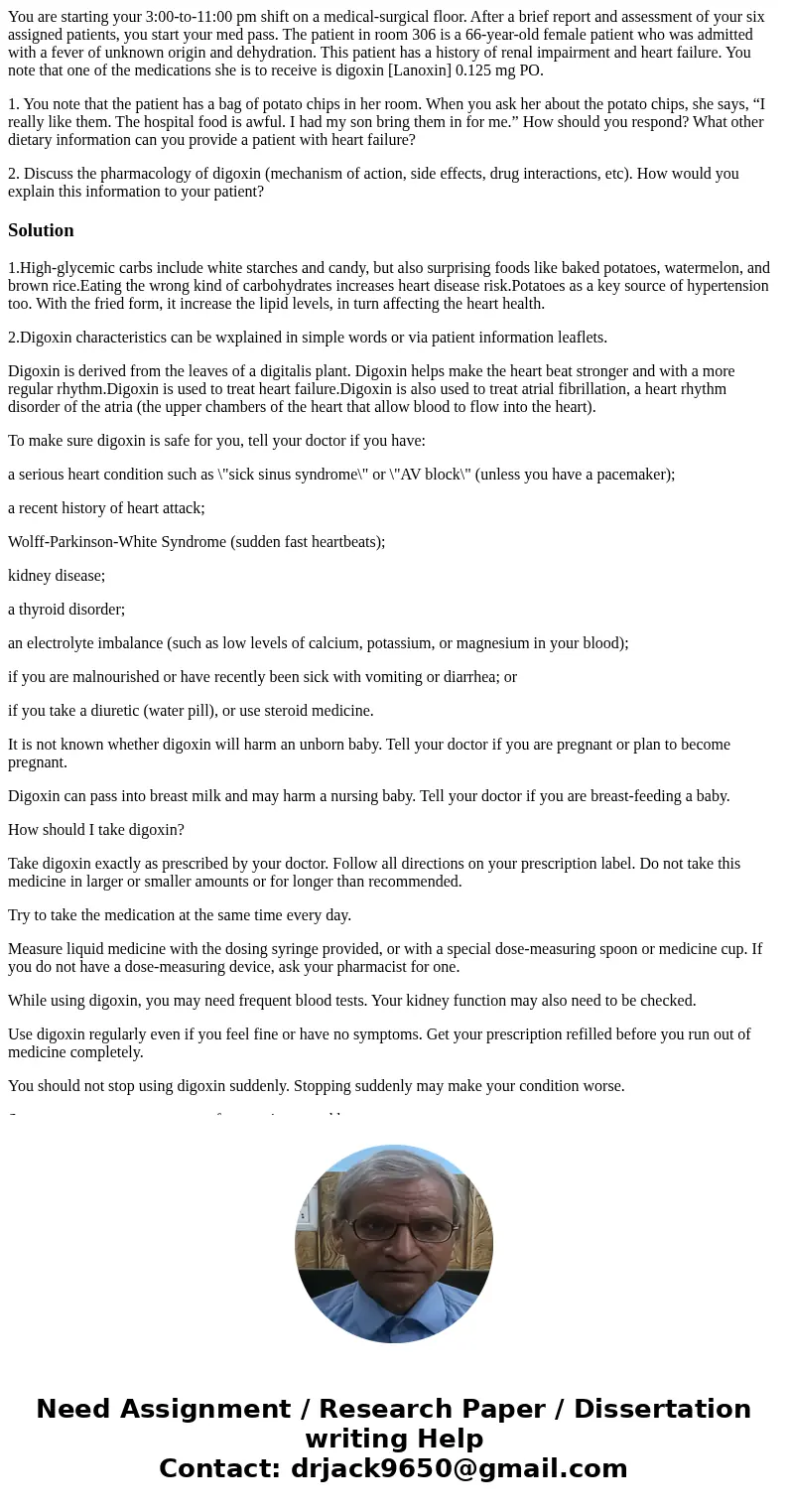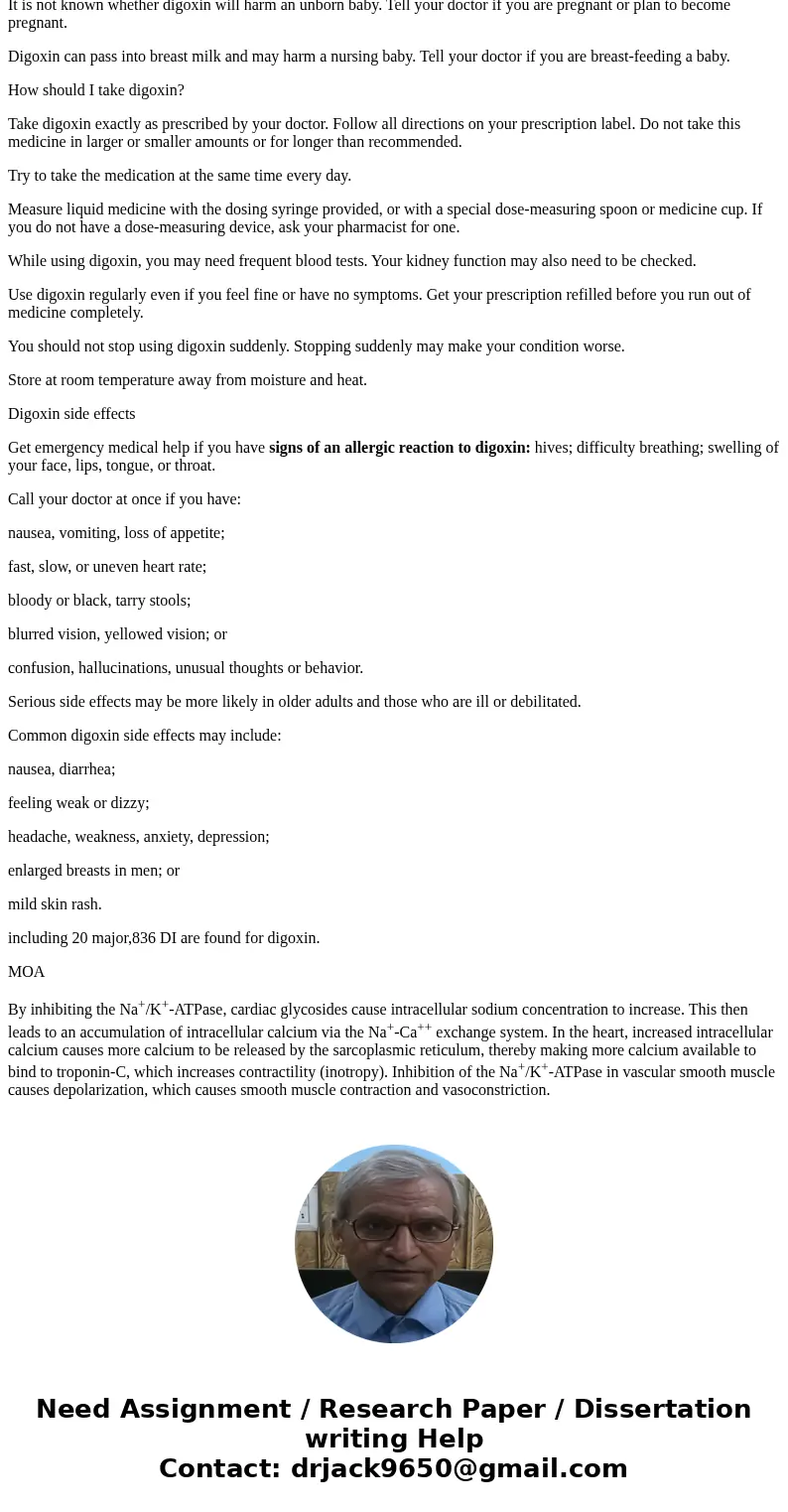You are starting your 300to1100 pm shift on a medicalsurgica
You are starting your 3:00-to-11:00 pm shift on a medical-surgical floor. After a brief report and assessment of your six assigned patients, you start your med pass. The patient in room 306 is a 66-year-old female patient who was admitted with a fever of unknown origin and dehydration. This patient has a history of renal impairment and heart failure. You note that one of the medications she is to receive is digoxin [Lanoxin] 0.125 mg PO.
1. You note that the patient has a bag of potato chips in her room. When you ask her about the potato chips, she says, “I really like them. The hospital food is awful. I had my son bring them in for me.” How should you respond? What other dietary information can you provide a patient with heart failure?
2. Discuss the pharmacology of digoxin (mechanism of action, side effects, drug interactions, etc). How would you explain this information to your patient?
Solution
1.High-glycemic carbs include white starches and candy, but also surprising foods like baked potatoes, watermelon, and brown rice.Eating the wrong kind of carbohydrates increases heart disease risk.Potatoes as a key source of hypertension too. With the fried form, it increase the lipid levels, in turn affecting the heart health.
2.Digoxin characteristics can be wxplained in simple words or via patient information leaflets.
Digoxin is derived from the leaves of a digitalis plant. Digoxin helps make the heart beat stronger and with a more regular rhythm.Digoxin is used to treat heart failure.Digoxin is also used to treat atrial fibrillation, a heart rhythm disorder of the atria (the upper chambers of the heart that allow blood to flow into the heart).
To make sure digoxin is safe for you, tell your doctor if you have:
a serious heart condition such as \"sick sinus syndrome\" or \"AV block\" (unless you have a pacemaker);
a recent history of heart attack;
Wolff-Parkinson-White Syndrome (sudden fast heartbeats);
kidney disease;
a thyroid disorder;
an electrolyte imbalance (such as low levels of calcium, potassium, or magnesium in your blood);
if you are malnourished or have recently been sick with vomiting or diarrhea; or
if you take a diuretic (water pill), or use steroid medicine.
It is not known whether digoxin will harm an unborn baby. Tell your doctor if you are pregnant or plan to become pregnant.
Digoxin can pass into breast milk and may harm a nursing baby. Tell your doctor if you are breast-feeding a baby.
How should I take digoxin?
Take digoxin exactly as prescribed by your doctor. Follow all directions on your prescription label. Do not take this medicine in larger or smaller amounts or for longer than recommended.
Try to take the medication at the same time every day.
Measure liquid medicine with the dosing syringe provided, or with a special dose-measuring spoon or medicine cup. If you do not have a dose-measuring device, ask your pharmacist for one.
While using digoxin, you may need frequent blood tests. Your kidney function may also need to be checked.
Use digoxin regularly even if you feel fine or have no symptoms. Get your prescription refilled before you run out of medicine completely.
You should not stop using digoxin suddenly. Stopping suddenly may make your condition worse.
Store at room temperature away from moisture and heat.
Digoxin side effects
Get emergency medical help if you have signs of an allergic reaction to digoxin: hives; difficulty breathing; swelling of your face, lips, tongue, or throat.
Call your doctor at once if you have:
nausea, vomiting, loss of appetite;
fast, slow, or uneven heart rate;
bloody or black, tarry stools;
blurred vision, yellowed vision; or
confusion, hallucinations, unusual thoughts or behavior.
Serious side effects may be more likely in older adults and those who are ill or debilitated.
Common digoxin side effects may include:
nausea, diarrhea;
feeling weak or dizzy;
headache, weakness, anxiety, depression;
enlarged breasts in men; or
mild skin rash.
including 20 major,836 DI are found for digoxin.
MOA
By inhibiting the Na+/K+-ATPase, cardiac glycosides cause intracellular sodium concentration to increase. This then leads to an accumulation of intracellular calcium via the Na+-Ca++ exchange system. In the heart, increased intracellular calcium causes more calcium to be released by the sarcoplasmic reticulum, thereby making more calcium available to bind to troponin-C, which increases contractility (inotropy). Inhibition of the Na+/K+-ATPase in vascular smooth muscle causes depolarization, which causes smooth muscle contraction and vasoconstriction.


 Homework Sourse
Homework Sourse